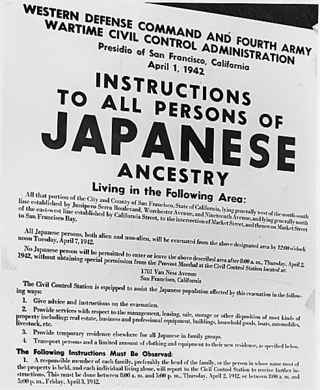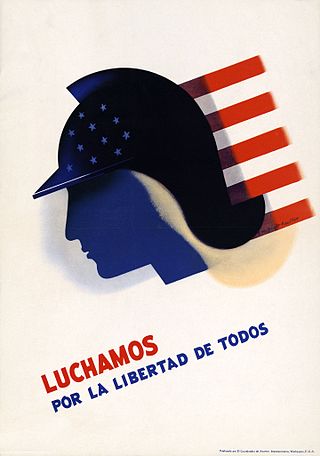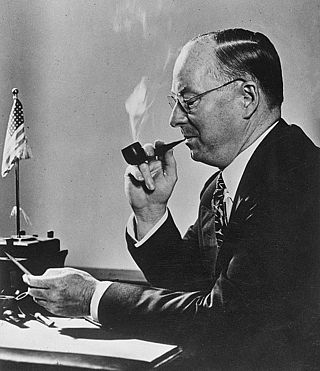Related Research Articles

Executive Order 9066 was a United States presidential executive order signed and issued during World War II by United States president Franklin D. Roosevelt on February 19, 1942. "This order authorized the forced removal of all persons deemed a threat to national security from the West Coast to "relocation centers" further inland—resulting in the incarceration of Japanese Americans." Two-thirds of them were U.S. citizens, born and raised in the United States.

Franklin Delano Roosevelt, commonly known by his initials FDR, was an American politician and statesman who served as the 32nd president of the United States from 1933 until his death in 1945. He was a member of the Democratic Party and is the only U.S. president to have served more than two terms in office. His third and fourth terms were dominated by World War II.

The Four Freedoms were goals articulated by U.S. President Franklin D. Roosevelt on Monday, January 6, 1941. In an address known as the Four Freedoms speech, he proposed four fundamental freedoms that people "everywhere in the world" ought to enjoy:
- Freedom of speech
- Freedom of worship
- Freedom from want
- Freedom from fear

The Executive Office of the President of the United States (EOP) comprises the offices and agencies that support the work of the president at the center of the executive branch of the United States federal government. The office consists of several offices and agencies, such as the White House Office, the National Security Council, and the Office of Management and Budget.

The Office of Insular Affairs (OIA) is a unit of the United States Department of the Interior that oversees federal administration of several United States insular areas. It is the successor to the Bureau of Insular Affairs of the War Department, which administered certain territories from 1902 to 1939, and the Office of Territorial Affairs in the Interior Department, which was responsible for certain territories from the 1930s to the 1990s. The word "insular" comes from the Latin word insula ("island").

Executive Order 8802 was signed by President Franklin D. Roosevelt on June 25, 1941, to prohibit ethnic or racial discrimination in the nation's defense industry, including in companies, unions, and federal agencies. It also set up the Fair Employment Practice Committee. It was the first federal action, though not a law, to promote equal opportunity and prohibit employment discrimination in the United States. Executive Order 8802 represented the first executive civil rights directive since Reconstruction.

The War Production Board (WPB) was an agency of the United States government that supervised war production during World War II. President Franklin D. Roosevelt established it in January 1942, with Executive Order 9024. The WPB replaced the Supply Priorities and Allocations Board and the Office of Production Management.

The Office of the Coordinator of Inter-American Affairs, later known as the Office for Inter-American Affairs, was a United States agency promoting inter-American cooperation (Pan-Americanism) during the 1940s, especially in commercial and economic areas. It was started in August 1940 as OCCCRBAR with Nelson Rockefeller as its head, appointed by President Franklin Delano Roosevelt.

The War Manpower Commission was a World War II agency of the United States Government charged with planning to balance the labor needs of agriculture, industry and the armed forces.

William Signius Knudsen was a leading Danish-American automotive industry executive and an American general during World War II. His experience and success as a key senior manager in the operations sides of Ford Motor Company and then General Motors led the Franklin Roosevelt administration to commission him directly as a lieutenant general in the United States Army to help lead the United States' war materiel production efforts for World War II.
The Office of War Mobilization (OWM) was an independent agency of the United States government formed during World War II to coordinate all government agencies involved in the war effort. It was formed on May 27, 1943 by Executive Order 9347.

The Office of Civil Defense (OCD) was an agency of the United States Department of Defense from 1961–64. It replaced the Office of Civil and Defense Mobilization. The organization was renamed the Defense Civil Preparedness Agency on May 5, 1972, and was abolished on July 20, 1979, pursuant to Executive Order 12148. Its duties were given to the Federal Emergency Management Agency (FEMA).

Donald Marr Nelson (1888–1959) was an American business executive and public servant, serving as the executive vice president of Sears Roebuck before accepting the position of director of priorities of the United States Office of Production Management (1941–1942). In 1942 Nelson became chairman of the War Production Board (1942–1944) when it replaced the OPM. He later served for two years (1945–1947) as president of the Society of Independent Motion Picture Producers.

The Office of Economic Stabilization was established within the United States Office for Emergency Management on October 3, 1942, pursuant to the Stabilization Act of 1942, as a means to control inflation during World War II through regulations on price, wage, and salary increases.

The War Powers Act of 1941, also known as the First War Powers Act, was an American emergency law that increased Federal power during World War II. The act was signed by U.S. President Franklin D. Roosevelt and put into law on December 18, 1941, less than two weeks after the Japanese attack on Pearl Harbor. The act was similar to the Departmental Reorganization Act of 1917 as it was signed shortly before the U.S. engaged in a large war and increased the powers of the president's U.S. Executive Branch.
The Fair Employment Practice Committee (FEPC) was created in 1941 in the United States to implement Executive Order 8802 by President Franklin D. Roosevelt "banning discriminatory employment practices by Federal agencies and all unions and companies engaged in war-related work." That was shortly before the United States entered World War II. The executive order also required federal vocational and training programs to be administered without discrimination. Established in the Office of Production Management, the FEPC was intended to help African Americans and other minorities obtain jobs in home front industries during World War II. In practice, especially in its later years, the committee also tried to open up more skilled jobs in industry to minorities, who had often been restricted to lowest-level work. The FEPC appeared to have contributed to substantial economic improvements among black men during the 1940s by helping them gain entry to more skilled and higher-paying positions in defense-related industries.

The War Food Administration was a United States government agency that existed from 1943 to 1945. The War Food Administration was responsible for the production and distribution of food to meet war and essential civilian needs during World War II. It was a predecessor of the Farm Service Agency.

The Supply Priorities and Allocations Board (SPAB) was a United States administrative entity within the Office for Emergency Management which was created and dissolved during World War II. The board was created by President Franklin D. Roosevelt via Executive Order 8875 on August 28, 1941, and dissolved less than five months later. The purpose of the Supply Priorities and Allocations Board was to coordinate the distribution of materials and commodities related to national defense and to assist the Office of Production Management (OPM) in carrying out their overlapping duties. The board's membership consisted of the director general and associate director general of the OPM, Secretary of War Henry L. Stimson, Secretary of the Navy Frank Knox, administrator of the Office of Price Administration Leon Henderson, chairman of the Economic Defense Board Henry A. Wallace and the special assistant to the president supervising the Lend-Lease program, Edward Stettinius, Jr. The president retained the power to appoint an executive director and to select the chairman of the board from its members. The only chairman of SPAB during its short lifespan was Vice President Wallace and its sole executive director was businessman Donald M. Nelson.

The third presidential term of Franklin D. Roosevelt began on January 20, 1941, when he was once again inaugurated as the 32nd president of the United States, and the fourth term of his presidency ended with his death on April 12, 1945. Roosevelt won a third term by defeating Republican nominee Wendell Willkie in the 1940 United States presidential election. He remains the only president to serve for more than two terms. Unlike his first two terms, Roosevelt's third and fourth terms were dominated by foreign policy concerns, as the United States became involved in World War II in December 1941.